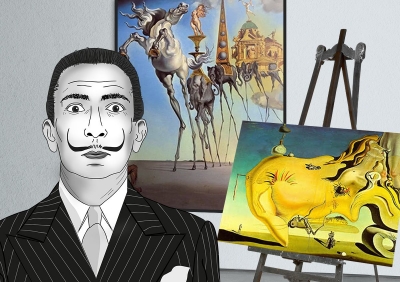
Salvador Dalí was a Spanish Surrealist painter and printmaker known for exploring subconscious imagery. Arguably, his most famous painting is The Persistence of Memory (1931), depicting limp melting watches.
“More than 100 years after his birth, the art world cannot quite figure out if Spanish Surrealist painter Salvador Dali (1904-89), was a genius or a madman!
He was just 14 when his works were first exhibited. At 17, he was admitted to the Royal Academy of Fine Arts in Madrid, but was expelled after four years for defying his teachers.
The French Surrealists were then trying to apply the theories of Sigmund Freud to painting and writing. Dali knew of Freud’s study of dreams and was fascinated with capturing them in paint.
International acclaim was not long in coming. In 1933, he put up solo exhibitions in Paris and New York City. He became Surrealism’s poster boy.
In addition to Freudian imagery – staircases, keys, dripping candles – he also used his own symbols. His most famous painting “The Persistence of Memory”, features three ‘melting’ watches, and a fourth covered by a swarm of ants. One of the watches is draped on a strange form that is meant to be Dali’s deflated head!
As his fame grew, Dali diversified into jewellery, clothes and furniture design, painted sets for ballets and plays, wrote fiction, produced a dream sequence for the Alfred Hitchcock thriller “Spellbound” and set up displays for store windows.
He cut an extremely eccentric figure, with his dashing clothes and moustache. He once showed up for a Paris lecture in a Rolls Royce stuffed with cauliflowers. For a book promotion in New York, he dressed in a golden robe and lay on a bed!
In 1974, Figueres in Catalonia, Spain, opened the Dali Theatre-Museum with works donated by him.
PROFILE OF TIME
In Dali’s paintings, the concept of time is different, it melts. Everything is fluidic. The Profile of Time, a sculpture by Dali, has the soft watch hanging and drooping from the branch of a tree. The watch appeared for the first time in Dali’s 1931 painting ‘The Persistence of Memory’. The watch can be seen to be melting and finishing off as a huge drop.
APPARITION OF FACE AND FRUIT DISH ON A BEACH
The painting by Dali works on illusion. He called them ‘double images’. In this, there are three simultaneous images at work in a single painting. Dali’s double image paintings had a huge fan following. It is more like a puzzle. Here, one can see an illusion of a face, the image of a dish full of fruits, that of a dog.
Picture Credit : Google










